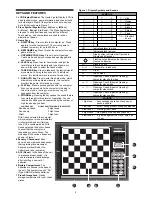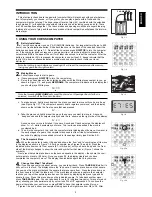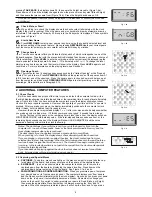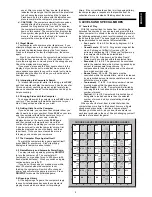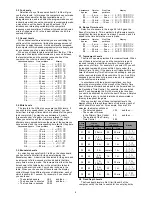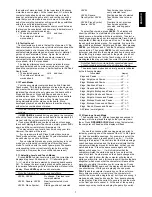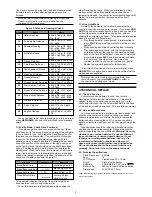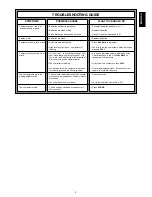
8
The clock is not used during this mode and NonAuto, when
selected, is only in effect after the opening moves are
finished.
Note that the method chosen for playing the Openings
Coach is retained in memory until batteries are
replaced of ACL is pressed.
When you want to get back to playing a normal game, just
press NEW GAME, and you will be returned to the standard
board.
3.13 Verify Mode. Check Piece Positions!
If the pieces get knocked over, or you think any of them
have been put in the wrong places, you can get the computer
to run a check for you. Just press the Piece Symbol key for
the piece you are questioning. The computer will show you
the symbol for the color and piece type, along with the
square on which it should be placed. Pressing the key again
shows the position of the next piece of that type, and so on
until all such pieces that should be on the board have been
shown. The display shows white pieces first, and then the
black pieces. When there are no more pieces of that type to
report, the display reverts to showing the side to move, and
sounds two ‘beeps’ to get your attention. An example of the
sequence of displays is shown in Figure 3-1.
This example indicates that one of the white knights has
been captured, and it is now white to play.
To verify other pieces, repeat the same steps using the
other Piece Symbol keys. When you are finished, simply
make your next move. Meanwhile the clock has been
temporarily stopped. The computer automatically exits Verify
Mode if no piece symbol key is pressed within about 5
seconds.
3.14 Non Auto Mode
Normally, the computer automatically answers with a
countermove whenever you enter a move. If you press NON
AUTO the computer responds with a ‘beep’ and you can then
enter all the moves for both sides, one by one, without
allowing the computer to answer! This special feature can be
used in a number of different ways:
• Play through master chess games. It is interesting to
press PLAY to see what the computer would do in any
position!
• Study opening book lines by entering them manually.
• Play chess against a friend, with the computer acting
as referee to check the legality of all moves and keep
track of the time for both sides! If you need help with a
move, simply press PLAY and the computer will make
the next move. After the move, Non Auto mode
remains in effect, and you can continue your game!
• Replay to any board position for further study.
To exit Non Auto mode and return to normal play, press
NON AUTO once again, and a double ‘beep’ verifies that the
mode has been canceled.
Note that Non Auto mode is also automatically can-
celed whenever you press NEW GAME or select a
Teach mode on exiting Level mode.
4 TECHNICAL DETAILS
4.1 The ACL Function
Computers can sometimes “lock up” due to static
discharge or other electrical disturbances. If this should
happen, take out the batteries and use a pin or a similar
sharp object to press into the hole marked ACL in the base
of the unit for at least one second. This resets the computer.
4.2 Care and Maintenance
Your chess computer is a precision electronic device, and
should not be subjected to rough handling or exposed to
extreme temperatures or moisture. Be sure to remove the
batteries before cleaning the unit. Do not use chemicals
agents or liquids to clean your unit, as they may damage the
plastic.
Weak batteries should be replaced promptly, since they
can leak and damage the computer. Please also note the
following regarding the use of batteries.
Warning: Use only
alkaline or zinc carbon batteries. Do not mix different
types of batteries or new and used batteries. Do not
recharge non-rechargeable batteries. Use only the
recommended batteries or equivalent. Be sure to
observe the correct polarity when inserting batteries.
Worn out batteries should be removed from the unit
promptly. Do not short circuit the supply terminals.
4.3 Technical Specifications
Clock Frequency:
4.2MHz
Keys:
14
LCD Display:
Viewing area 30 x 13 mm
Sound:
Piezo-electric buzzer
Batteries:
3 AA/AM3/R6 (1.5V) cells
Battery Life:
600 hrs for new alkaline batteries
Dimensions:
314 X 252 X 34 mm
Saitek reserves the right to make technical changes without notice in the
interest of progress.
Square
Name
Moves
Italian Opening
Two Knights Defense
Spanish Opening
Sicilian Defense
French Defense
Caro-Kann Defense
Scandinavian Defense
Alekhine’s Defense
Queen’s Gambit
Queen’s Gambit Accepted
Nimzo-Indian Defense
Queen’s Indian Defense
King’s Indian Defense
Gruenfeld Defense
Dutch Defense
English Opening
e2e4, e7e5, g1f3, b8c6,
f1c4, f8c5
e2e4, e7e5, g1f3, b8c6,
f1c4, g8f6
e2e4, e7e5, g1f3, b8c6,
f1b5, a7a6, b5a4, g8f6,
e1g1, b7b5
e2e4, c7c5, g1f3, d7d6,
d2d4, c5d4, f3d4, g8f6,
b1c3
e2e4, e7e6, d2d4, d7d5
e2e4, c7c6, d2d4, d7d5,
b1c3, d5e4
e2e4, d7d5, e4d5, d8d5,
b1c3, d5a5
e2e4, g8f6, e4e5, f6d5
d2d4, d7d5, c2c4, e7e6,
b1c3, g8f6, c1g5, f8e7
d2d4, d7d5, c2c4, d5c4
d2d4, g8f6, c2c4, e7e6,
b1c3, f8b4
d2d4, g8f6, c2c4, e7e6,
g1f3, b7b6
d2d4, g8f6, c2c4, g7g6,
b1c3, f8g7, e2e4, d7d6
d2d4, g8f6, c2c4, g7g6,
b1c3, d7d5
d2d4, f7f5, c2c4, g8f6,
b1c3, e7e6
c2c4, e7e5, b1c3, g8f6,
g1f3
A1
A2
A3
A4
A5
A6
A7
A8
B1
B2
B3
B4
B5
B6
B7
B8
Figure 3-1 Moves in Openings Coach
Key Press
Display Shows
Meanings
Press
™
first time
Press
™
second time
Press
™
third time
Press
™
fourth time
zn:B1
Zn:B8
n:F6
zn:zz
(beep, beep)
White Knight on B1
Black Knight on B8
black Knight on F6
no more Knight,
white-to-move


